PFM Good Practices
As a purpose-led organization, FreeBalance is committed to building Public Financial Management (PFM) capacity around the world. One of the ways we do this is by sharing good practices that governments can follow in their PFM reform journeys.
This the first such practice note and it describes methods of calculating the Total Cost of Ownership (TCO) for Integrated Financial Management Information Systems (IFMIS) such as FreeBalance’s Government Resource Planning solution, the FreeBalance Accountability Suite™.
What is Total Cost of Ownership?
The total cost of ownership (TCO) is the purchase price of an asset plus the long-term costs and expenses incurred during the product’s useful life and ultimate disposal. In the case of an IFMIS implementation this includes upfront consulting costs, equipment and infrastructure costs, software and license costs, and internal costs such as training.
TCO is a critical concept because of the high risk of IT failure in the public sector and the high ERP failure rate in government . The monitoring of upgrade costs, employee retention, customization burden and electricity draw is an early warning system for IT failure. And, TCO tells you whether your GRP project is financially sustainable.
Why Is TCO Important?
Governments implement Government Resource Planning (GRP) or Enterprise Resource Planning (ERP) software to improve Public Financial Management (PFM), fiscal discipline, government efficiency and Value for Money (V4M) in delivery of services to citizens. However, the initial cost of the IFMIS may not reflect the TCO borne by government organizations.
Many government organizations fail to calculate the many long-term internal costs are incurred to use, manage and maintain ERP software over many years, yet this is a key element of V4M fiscal discipline. TCO is critical to financial sustainability because PFM reform is an ongoing process. Governments should therefore consider more than the maintenance of a “steady state” and should calculate the costs of progressive modernization and digital transformation.
Average cost by category for enterprise software differs among analysts depending on data completeness, category definitions and the duration analyzed. Nevertheless, studies show that consulting for implementation tends to be the highest cost.
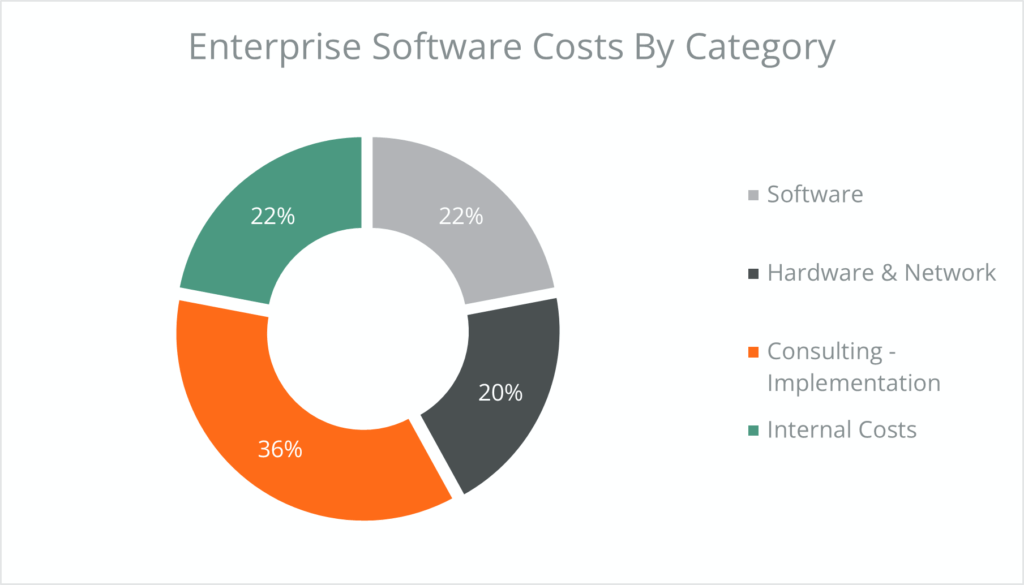
The TCO Reality
Analysis of the TCO of IFMIS systems reveals some shocking facts:
- High implementation costs ranging from a 1:1 ratio in the private sector to 3:1 to 15:1 in the public sector with examples where services significantly exceeded other costs.
- Average TCO measured at over $50,000 per user in one analyst study making this a material cost to government budgets. Governments are legally “budget driven” where high TCO and unexpected cost overruns may require supplemental budgets or extracting funds from other priorities.
- High maintenance costs that originate from maintaining complex code and problem troubleshooting, and difficult upgrades that can increase TCO after the initial implementation.
- High upgrade costs increase the TCO where ERP upgrades are estimated to be ½ the value of the original license fee and 20% of the original implementation costs. Experts warn that organizations should expect to pay as much as three times the original ERP software cost to upgrade to new technology.
- Unexpected risk costs with average ERP implementation variance of two and four months over schedule in one study, 230% of schedule in another study, and up to 80% of ERP exceed time and budget estimates in a third study.
- Additional sustainability costs for staff retention and certification. Some ERP solutions have expensive functional and technical training courses required to certify government staff. Civil servants often leverage this certification to join private companies meaning that governments need programs to retain talent and prevent this brain drain.
IFMIS Acquisition Costs
- Internal personnel costs and consulting fees for needs analysis and the development and maintenance of a request for proposal. Procurement costs including engaging financial and IT experts throughout the process. Government procurement cycles for GRP tend to be lengthy.
- Computing hardware, networking and required bandwidth for the computing infrastructure to support the GRP. This includes disaster recovery sites, testing centre, provisioning of reliable power and long-term telecommunications contracts. This also includes the personnel costs to accept shipments of equipment.
- Middleware software including security, database, load-balancing, operating systems and systems management tools necessary to support the implementation.
- Software license costs are typically based on the number of (named or concurrent) users or size of the government.
IFMIS Implementation Costs
- Project management costs including dedicated employees to project, program management office, communications and meetings.
- Installation, provisioning and set up of the GRP software and middleware.
- Internal personnel costs and consultant costs to articulate the current business processes, legal requirements, forms and report requirements and to manage old and new systems in parallel.
- Internal personnel costs and consultant costs for any changes to current processes required by the software or good practices. This could include comprehensive business process re-engineering and additional staff training.
- Data conversion costs including quality assurance. This can also include data completeness analysis where information that is not in the current system needs to be uncovered from other sources.
- Configuration and customization costs, typically accomplished by external consultants or software vendors. This covers adapting the core software and integration, reports and forms.
- Internal personnel and consultant costs for piloting, analyzing and acceptance testing following quality assurance processes.
- Technical training for middleware, networks, computers and systems management. Functional training for GRP users.
- Development of any special documentation or user guides that describe the government processes and how these are accomplished within the software.
- Additional implementation phases may occur such as adding additional software modules, more users or new government entities.
Ongoing IFMIS Costs
- Maintenance costs for all hardware and software purchase, which includes vendor customer support. This is typically an annual contract.
- Government personnel acting as first line support for equipment and software. This also includes case management to track bugs and enhancements while maintaining the vendor relationship
- System tuning of databases, operating systems and networks as number of transactions increase.
- Changes to configuration and customization of reports or forms accomplished by internal staff or consultants.
- Data centre bandwidth, telecommunication, electricity and rental / lease / space costs.
- New fiscal year processing including carry-over of previous year funds accomplished by internal staff or consultants.
- Upgrade costs associated with moving to newer software versions. This includes change management to ensure that any customization accomplished in the previous version is added to the next, with full acceptance testing.
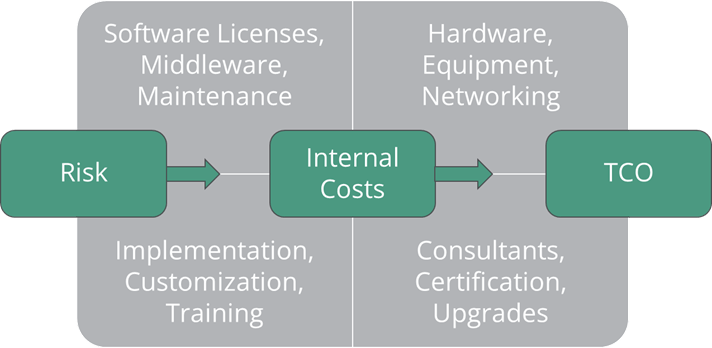
Hidden IFMIS Costs
Total costs change through the lifecycle of GRP usage where implementation costs are higher than those for an additional year of ‘steady state’. Additional per year costs can mount because of software upgrades, government modernization and unexpected costs.
- Lost productivity as systems are run in parallel
- Costs implied in the employee learning curve
- Reduced efficiency by adding so-called “best-practices” that adds complexity to existing processes
- Change management costs for new government regulations and training on processes within the software
- Disaster, lost data, business disruption through late implementation or system failures including audit and reporting disruption
- User conference and training travel and expenses charges to keep up to date on software changes
- License audits where vendor demands additional payments
- Maintenance options may require additional payments to achieve necessary service to overcome problems
- Unexpected add-ons when product portfolio does not meet entire requirement
- Middleware changes such as operating system or databases outside the GRP system upgrade period
TCO Impacts to Governments
Government enterprise software implementations are more complex:
- Many more lines of business across a national or sub-national government, than business conglomerates
- High human capacity constraints in technology, project, and functional knowledge
- More complex performance management structures and planning because government does not have a bottom-line like profit or loss
- Higher practice diversity because of legal requirements
- More complex planning through multiple-year budgets that create controls in systems for commitment accounting
- Significant political concerns for public sector implementations
Adapting private sector ERP systems for government increases the amount of customization required to support legal processes and public sector financial standards. By comparison, GRP software which by the design focuses on government only, leverages configuration as the primary mechanism of meeting government needs.
Code customization comes with high costs and future adaptability challenges all of which generates technical debt.
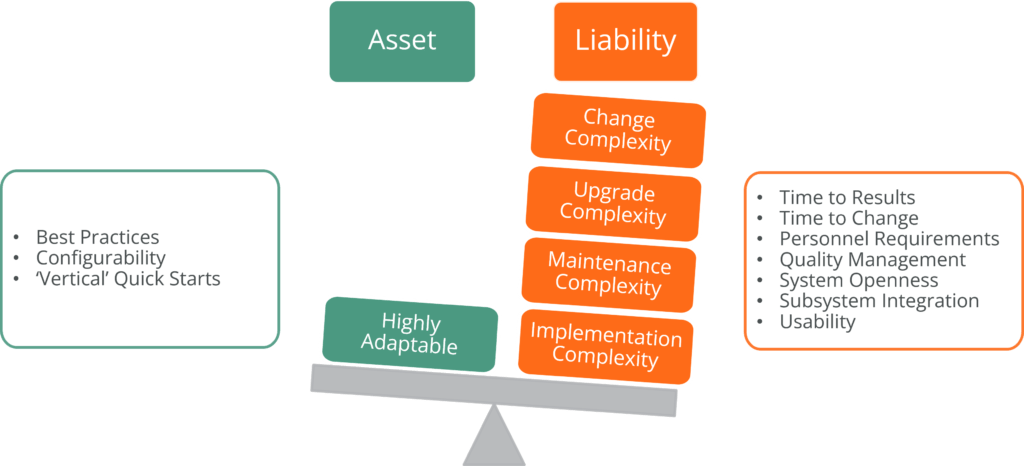
The larger technical footprint of ERP systems means requiring multiple computers and application servers and consuming large amounts of disk space that increases the TCO beyond the initial cost. The sophistication of the larger technical footprint also requires more internal support, better software tools and higher technical capacity.

However, the public sector often has lower technical capacity, especially in developing countries. Developing this capacity increases the TCO. Some ERP applications require significant technical knowledge to implement and support, including systems management and database tuning, often requiring permanently contracted external consultants.
In addition, lower accounting functional capacity of the public service in some countries may require additional PFM training. Some systems are designed for more complex accrual accounting while other systems have complex business processes that must be followed by public servants.
Other Factors to Consider
Footprint: hardware and bandwidth footprint including replication services can add significantly to space, equipment and electricity costs.
Leverage: the importance of the government market to the software manufacturer is critical to ensuring that product upgrades meet emerging needs otherwise customization costs increase year over year.
Governance: many GRP projects create governance structures with Systems Integration firms but without the software manufacturer. This reduces the manufacturer commitment to meet government needs over time.
Our analysis shows that the TCO for GRP systems such as the FreeBalance Accountability Suite™ is on average 225% lower than software designed for the private sector such as ERP.
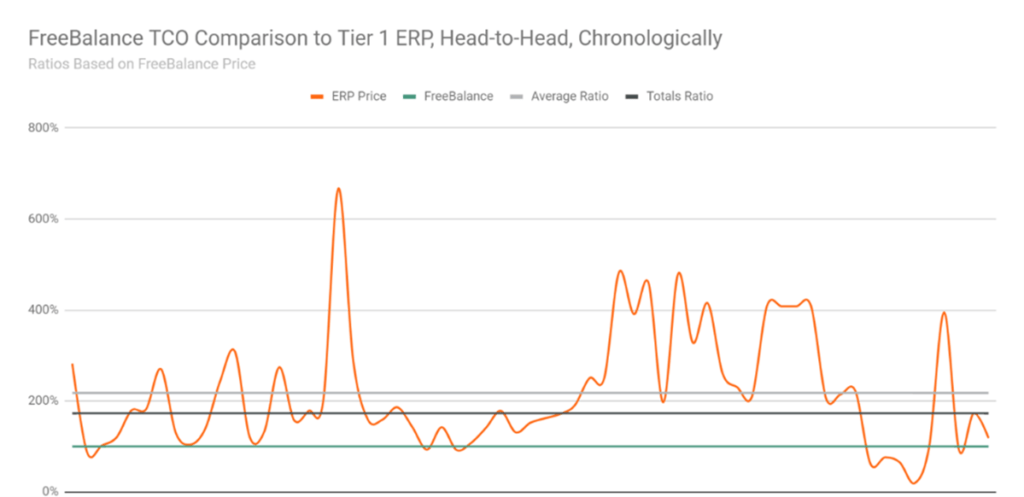
Risk Management
A risk management approach identifies risk factors, risk appetite and risk mitigation strategies. Elements to consider in developing a government’s risk management approach should include organizational capacity, vendor success ratio, and the extent of expected customization. Risk mitigation strategies also add costs to an IFMIS project.
These risk factors can be used to calculate an expected budget overruns and should be considered when determining the potential TCO for any software acquisition.
Conclusion
Good Practices in TCO Considerations
FreeBalance’s recommendation to governments that are considering the cost implications of a digital transformation and modernization of their IFMIS is to remember that there are very few ‘best practices’ but many ‘good practices’ in Public Financial Management.
Governments should therefore be mindful of vendors’ claims and rather consider:
- A risk management approach based on industry experience in similar projects
- The extent of required customization, the level of commitment by the software manufacturer to the government market and the customer can be used to calculate expected budget overruns and some hidden costs can be estimated.
- Governance structures and leverage with the software manufacturer should be included in the risk calculation.
- A long-term project approach should identify increased per-year costs by the vendor. The version upgrade path and vendor’s upgrade policies should be interrogated to identify future costs.
- The multiple-year project plan should act as input into the IT budget.
- Customization costs for the initial implementation should be used as an anchor to calculate future software upgrade and customization changes. Industry figures for average duration of upgrades should be used.
In addition, the government’s experience with software vendors should be modelled to determine expected implementation and maintenance costs. And a turnkey approach should be used to commit a single provider or consortium to assume a fixed-price schedule.
Lastly, employee retention and turnover should be analyzed and these internal costs should be modelled as part of the TCO calculation. This includes the expected costs for additional training and certification.
FreeBalance Accountability Suite™
FreeBalance has worked alongside the public sector for almost 40 years to develop and deliver government software solutions that support PFM reform and modernization.
The FreeBalance Accountability Suite™ is a commercial off-the-shelf, GRP solution that covers the entire budget cycle and manages all critical government fiscal systems. The FreeBalance Accountability Suite™ is available in six base configurations to meet different GRP requirements.

The entire FreeBalance portfolio is built on the FreeBalance Accountability Platform™, a web-based, Java-powered platform designed exclusively for government financial management. The platform supports centralized, decentralized or hybrid deployment models.
- Postmodern Design
Postmodern Design through ease of integration, massive configurability and flexible on-premises, private cloud, public cloud, community cloud and shared services support - Web Native
Web Native using international web standards, no legacy software code deployed via the web and no web translation layer - Open System
Open System supporting robust open source and commercial infrastructure through recognized industry standards, providing more choices - Unified Design
Unified Design through component reuse across all applications, centralized metadata management, with ease of reporting - Highly Extensible
Highly Extensible supporting additional functions and custom development thanks to a Service Oriented Architecture (SOA) and component reuse across applications - Progressive Activation
Progressive Activation enables future configuration changes, process modernization, fiscal decentralization, and adding additional modules
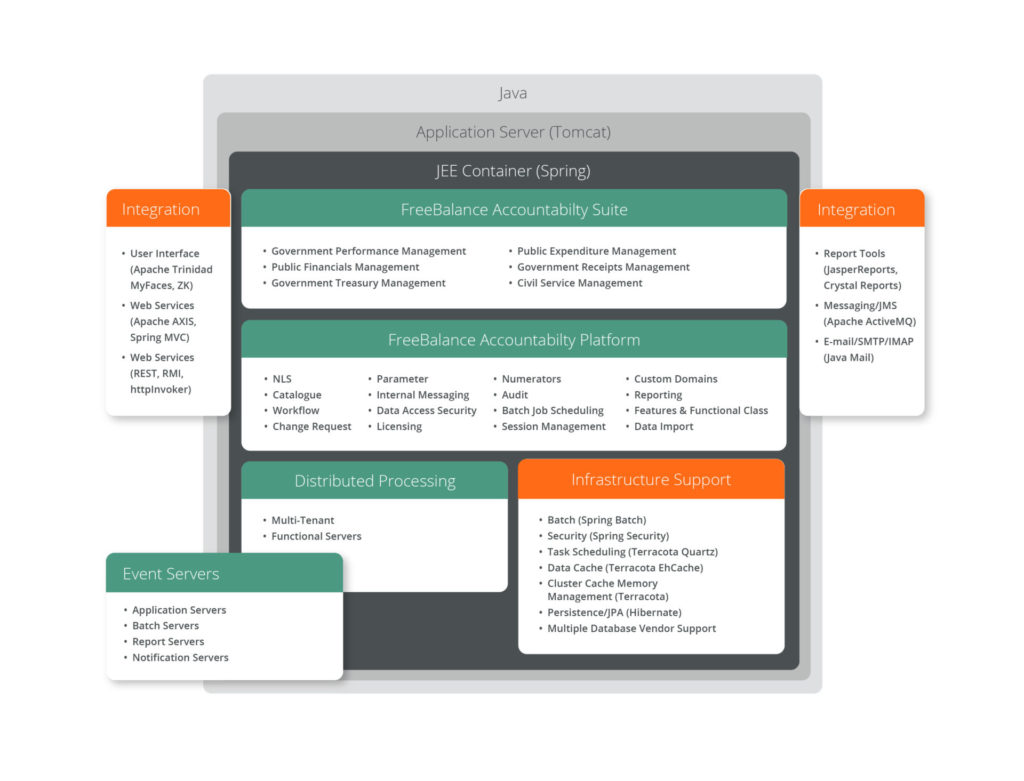
FreeBalance TCO
To ensure a low total cost of ownership, the FreeBalance Accountability Platform™ provides many efficiencies for government which means better value for money for taxpayers.
Modular Approach
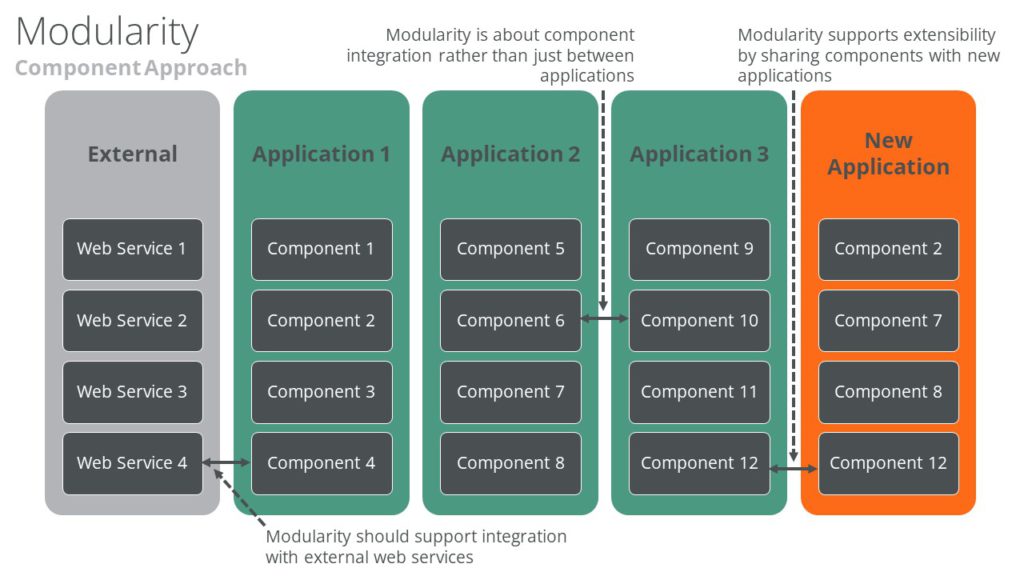
The ability to add modules over time enables governments to implement critical functions based on the country context. This approach represents a quicker path to value for money and enables progressive activation – continued and sustained activation of required PFM functionality based on country governance needs.
Progressive Activation
While there is general agreement that PFM and institutional reform is critical to improving governance, the pace of reforms often slows because of the inability of information systems to adapt to new needs.
The pace of PFM reform needs to be sustainable to have lasting governance improvements and the IFMIS used must enable rather than prevent reform. While there have been numerous ERP failures in government, the FreeBalance Accountability Suite™ has a demonstrated higher success rate.

Minimal IT Support
The optimized technical footprint of the FreeBalance Accountability Platform™ reduces the burden on IT to manage computer systems, networks and middleware software.